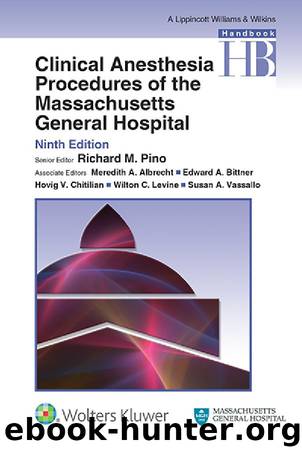Clinical Anesthesia Procedures of the Massachusetts General Hospital by Richard M. Pino

Author:Richard M. Pino [Pino, Richard M.]
Language: eng
Format: epub
Publisher: LWW
Published: 2015-08-09T22:00:00+00:00
II. PERIPHERAL ARTERIAL SURGERY
A. General Considerations
Peripheral arterial procedures include the bypass or stenting of stenotic arteries; embolectomy of occluded arteries; and the repair of peripheral arterial aneurysms. Endovascular approaches are employed whenever possible and are typically performed in the operating room, angiography suites, or hybrid operating rooms. Special considerations for the provision of anesthesia outside of the operating room are discussed in Chapter 33.
B. Percutaneous Balloon Angioplasty and Stenting
Limb patency and amputation-free survival rates are similar to open bypass surgery. Patients must have a target lesion amenable to the endovascular approach: typically a focal short-segment occlusion with patent vessels distal to the treated lesion (i.e., “good runoff”). Advantages of percutaneous therapy include faster patient recovery, shorter hospital stay, smaller wounds with lower complication rates, and potential cost savings. Procedures on the upper and lower extremities are typically performed in the operating room angiography suites and are frequently done under local anesthesia with sedation.
1. Surgical approach may be percutaneous or through a cutdown to the artery. Brachial artery access may be required necessitating IV placement and blood pressure monitoring on the contralateral arm.
2. Large amounts of intravenous contrast dye may be administered and may require prophylaxis for CIN (see “Renal System” under section I, above).
3. Anesthetic technique frequently involves monitored anesthesia care with standard monitors. Local anesthesia typically provides sufficient analgesia. Provisions should be made to allow for conversion to general anesthesia in the case of an unplanned conversion to open repair.
4. IV unfractionated heparin is often used as an adjunct and is given prior to arterial cannulation. A vasodilator may be administered intra-arterially by the surgeon to treat catheter or wire-induced vasospasm. Treatment of systemic effects may be required.
5. Distal embolization is a potential serious complication with aggressive endovascular instrumentation.
C. Lower-Extremity Bypass Grafting
In the presence of multisegment disease or poor distal runoff, open surgical bypass of the lower extremity is preferred over the endovascular approach. An autologous saphenous vein graft is the most commonly used conduit. If this is not available, or is of unacceptable quality, an upper extremity vein from the patient or cryopreserved cadaveric vein may be used. Preparation of the vein and subsequent anastomoses to the arterial circulation may be time consuming but rarely place significant hemodynamic stress on the patient. The use of synthetic grafts in selected patients may reduce the length of these procedures. Blood loss is usually minimal, but it may be significant with revision of a previous bypass. Routine monitoring is usually sufficient. Patient comorbidities or surgical complexity may warrant placement of invasive monitors. No significant differences in morbidity or mortality have been demonstrated between regional anesthesia and general anesthesia for lower limb revascularization.
1. General anesthesia. Any technique is appropriate provided hemodynamic stability is maintained.
2. Regional anesthesia. Potential advantages may include sympathetic blockade, improved pain control, lack of airway instrumentation, improved ability to detect symptoms of myocardial ischemia in an awake patient, and reduced incidence of pneumonia. However, long procedures under regional anesthesia can pose a challenge for patients who may become uncomfortable and restless.
Download
This site does not store any files on its server. We only index and link to content provided by other sites. Please contact the content providers to delete copyright contents if any and email us, we'll remove relevant links or contents immediately.
| Anesthesiology | Colon & Rectal |
| General Surgery | Laparoscopic & Robotic |
| Neurosurgery | Ophthalmology |
| Oral & Maxillofacial | Orthopedics |
| Otolaryngology | Plastic |
| Thoracic & Vascular | Transplants |
| Trauma |
Periodization Training for Sports by Tudor Bompa(8173)
Why We Sleep: Unlocking the Power of Sleep and Dreams by Matthew Walker(6620)
Paper Towns by Green John(5092)
The Immortal Life of Henrietta Lacks by Rebecca Skloot(4528)
The Sports Rules Book by Human Kinetics(4299)
Dynamic Alignment Through Imagery by Eric Franklin(4120)
ACSM's Complete Guide to Fitness & Health by ACSM(3991)
Kaplan MCAT Organic Chemistry Review: Created for MCAT 2015 (Kaplan Test Prep) by Kaplan(3941)
Introduction to Kinesiology by Shirl J. Hoffman(3728)
Livewired by David Eagleman(3686)
The Death of the Heart by Elizabeth Bowen(3554)
The River of Consciousness by Oliver Sacks(3543)
Alchemy and Alchemists by C. J. S. Thompson(3452)
Bad Pharma by Ben Goldacre(3358)
Descartes' Error by Antonio Damasio(3232)
The Emperor of All Maladies: A Biography of Cancer by Siddhartha Mukherjee(3070)
The Gene: An Intimate History by Siddhartha Mukherjee(3050)
The Fate of Rome: Climate, Disease, and the End of an Empire (The Princeton History of the Ancient World) by Kyle Harper(3007)
Kaplan MCAT Behavioral Sciences Review: Created for MCAT 2015 (Kaplan Test Prep) by Kaplan(2941)
